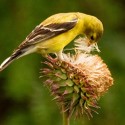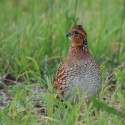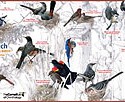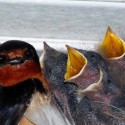 Photo ©
Keith Williams
Photo ©
Keith Williams

Featured species: American Goldfinch
While nesting season for most birds is winding down, this is a great time to monitor American Goldfinch nests. These birds, found throughout much of the northern and eastern U.S., don’t begin breeding until late June with peak nesting occurring in late July and early August. This delayed nesting ensures that the fluffy down of milkweed, thistle, and other plants, which goldfinches use to build their nests, is readily available. Goldfinches are also strict vegetarians, so nesting later in the summer ensures that there are plenty of seeds available to feed their hungry nestlings. You can find American Goldfinch nests in shrubby, open areas with tall grass. Their cup nests, measuring about 3 inches across and 3-4 inches high, are usually lashed among several twigs in a shrub or small tree, and can be positioned from just above the ground to several meters high. The fibers of the nest are woven so tightly that the nest bowl can hold water.
American Goldfinches lay 2-7 eggs per nest. Their eggs hatch after 2 weeks of incubation, and nestlings will be ready to be on their own in about another 12 days. There are only 10 American Goldfinch nests in the NestWatch database–please help us add to this total. Read more about American Goldfinches on the NestWatch Focal Species page and on the All About Birds species profile.

Predator removal may not increase nesting success
You may have experienced the disappointment that accompanies a nest failure, whether due to bad weather, nest parasitism, or predators. When a predator raids a nest that you monitor, it is common to wonder if there is anything that you can do to eliminate this threat. But before you blame that snake or raccoon, please consider that every animal has a role to play in its environment and birds have always experienced such losses to some degree. Also, eliminating specific nest predators from an area may have little impact on the overall survival of bird populations.
Scientists recently observed nests of Northern Bobwhite with cameras to learn if predator removal would increase bobwhite nesting success. (This species nests on the ground and typically has low nesting success.) They found that the removal of common predators, like raccoons, opossums, and armadillos, did make these species less abundant within the area, but it did not increase the bobwhites’ nesting success. When these predators were removed, other less common predators, such as snakes, rodents, and fire ants, preyed on nests instead. This effect is known as compensatory mortality, and it applies to fledglings and adult birds, too. Although it’s upsetting to witness the consequences of a predator visiting a nest, keep in mind that it’s impossible to completely eradicate all predators and removing one primary predator from an area can actually make matters worse by allowing other nest predators, which were formerly kept in check by the primary predator, to thrive. Take heart, though, because a good number of young birds do fledge–many of them, no doubt, thanks to the favorable habitat and predator guards provided by many nest monitors. For tips on safeguarding nests, read our article on Dealing with Predators and our Code of Conduct.
Reference: Ellis-Felege, S. N., M. J. Conroy, W. E. Palmer, and J. P. Carroll. 2012. Predator reduction results in compensatory shifts in losses of avian ground nests. Journal of Applied Ecology 49(3):661-669.

Help Break Records
You can now track how many nests have been monitored this year for some of our more popular species on the NestWatch homepage. Follow along as we attempt to break our annual records. Submit your observations and push us over the top! We’ve already had more American Robin, Northern Cardinal, Northern Mockingbird, and Eastern Phoebe nests monitored in 2012 than in any other previous year.
Website Update
The 2012 Quick Summary is back on the Your Data page, and it’s now officially real-time! Counts of eggs and nestlings from ongoing nesting attempts are automatically included in your tallies.

Monthly Winner
At the beginning of each month, NestWatch randomly selects one participant to receive a copy of the NestWatch Common Nesting Birds of North America poster. This month’s lucky winner is Jeannette Loughman. Congratulations, Jeannette!

2012 NestWatch Pledge Drive
Thank you so much for participating in NestWatch this season. Over the past month, generous NestWatchers like you have contributed $1,034.88. We’re over one-third of the way to our goal of raising $3,000 by the end of the nesting season to help fund workshops to train NestWatch Chapter coordinators next spring. Last year, more than 3,000 people submitted nest observations. If each of you contributes our suggested participation fee of just $10, we would be able to support much of our operational expenses. For donations of $25 or more, you will receive a NestWatch poster! Please consider making a contribution today. We sincerely appreciate your kindness! The future of NestWatch truly is in your hands.